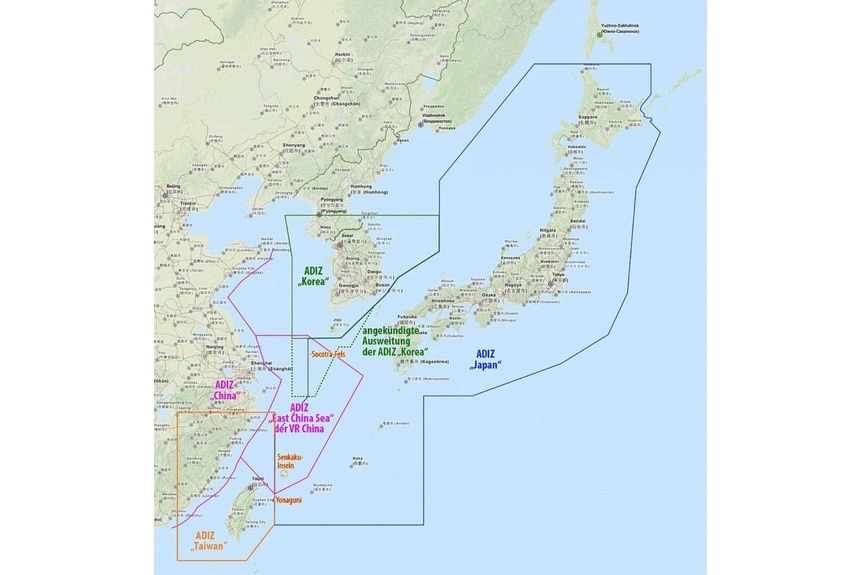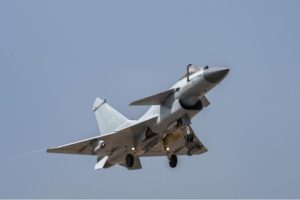
China Increases Presence in East China Sea To Change Status Quo
By Cindy Hurst

The East China Sea. The pink line represents the both the regular Chinese ADIZ and the ECS ADIZ.
“We can only move forward, not backward. We will never let even 1 millimeter of our territory taken.” -Xi Jinping
China is reportedly deploying multiple warships near the borders of its East China Sea (ECS) air defense identification zone (ADIZ) for at least the next year.[i] The action by the PLA Navy raises concern for nearby Japan. According to the first article excerpt published in one of Japan’s leading newspapers, Yomiuri Shimbun, Japanese sources have observed a Jiangkai II-class [RG1] guided missile frigate and a highly capable air defense missile destroyer in the ECS.[ii] Japan is concerned by China’s operational posture within its unilaterally established ECS ADIZ. As the article explains, instead of allowing freedom of navigation in international airspace recognized in international law, China is operating as if its ECS zone falls under their jurisdiction, often warning foreign aircraft within the ADIZ that it will take “defensive emergency measures” if they do not leave immediately.
Concern surrounding the ECS ADIZ is not new. This zone differs from others as it intentionally overlaps portions of ADIZs maintained by Japan, Taiwan, and South Korea.[iii] The overlapping zones could create potential flashpoints, especially in areas in which disputed territories are involved. For example, both ADIZs maintained by China and Japan overlap the highly disputed, Japanese-administered Senkaku Islands, located adjacent to Taiwan. According to the second article excerpt, published through Tokyo-based nonprofit news agency Kyodo News, China’s Coast Guard drafted a plan to maintain its presence around the Senkakus, (also known as Diaoyu in China) throughout 2024. This decision came after Chinese President Xi Jinping pointed out the need for China to “constantly strengthen” its efforts to safeguard the sovereignty of the islands. The last excerpted article, also published in Yomiuri Shimbun, points out that China is strengthening its anti-access/area denial strategy while also exerting military pressure on Taiwan.[iv] The article describes China having four ships deployed around the clock, working closely with fighters, and increasing military activities. It adds that China will likely aim to block U.S. and Japan Self Defense Forces aircraft from entering the airspace in the event of a conflict over Taiwan. Meanwhile, an expert cited in the article points out that a Chinese invasion of Taiwan could include a concurrent “Senkaku contingency” because China claims the Senkakus are part of Taiwan.
Sources:
“China Deploys Multiple Warships Around Self-Claimed ADIZ,” Yomiuri Shimbun (one of Japan’s five major newspapers), 28 January 2024. https://japannews.yomiuri.co.jp/politics/defense-security/20240128-165250/
China is deploying multiple warships around the clock in waters near the borders of the air defense identification zone that it has unilaterally established, The Yomiuri Shimbun has learned.
China is operating the zone on the premise that it is Chinese airspace. Aircraft that fly within its ADIZ are told to immediately leave.
Contrary to international custom, China unilaterally demands that aircraft flying in the zone follow Chinese authorities’ instructions. It also claims it will take “defensive emergency measures” if an aircraft fails to do so.
China started deploying at least three navy warships around the clock in waters around its claimed ADIZ, according to Japanese government sources. The three include an air defense missile destroyer, which is the Chinese version of an Aegis-equipped destroyer, and a frigate warship. Equipped with high-performance radar, air defense missile destroyers are highly capable of shooting down aircraft. The Chinese military aircraft repeatedly scramble in response to SDF aircraft, according to the sources. The Chinese military is believed to be strengthening its monitoring of SDF and U.S. military aircraft and warships in the East China Sea.
China’s monitoring capabilities were initially believed to be low, and it was thought that its establishment of the ADIZ would have no substantial impact. However, some observers are warning that China will have its warships, which are deployed around the clock, and fighters work together and increase its military activities. “It’s intended to block the SDF and U.S. military aircraft [from entering the airspace] in the event of contingencies in the Taiwan Strait,” said an SDF source.
“China Plans To Keep Ships Near Senkakus 365 Days in 2024,” Kyodo News (Tokyo-based non-profit news agency), 30 December 2024. https://english.kyodonews.net/news/2023/12/eb55266c4a9f-china-plans-to-keep-ships-near-senkakus-365-days-in-2024.html?phrase=Senkaku&words=Senkakus,Senkaku
China plans to keep its ships near the Japan-controlled Senkaku Islands in the East China Sea for 365 days in 2024 as leader Xi Jinping has called for bolstering Beijing’s sovereignty claim over the islets, sources familiar with the matter said Saturday.
During a rare visit by Xi on Nov. 29 to the command office for the East China Sea area of the China Coast Guard in Shanghai, the president pointed out the need for Beijing to “constantly strengthen” its efforts to safeguard the sovereignty of the islands, which China calls
Diaoyu, the sources said.
Xi, who also heads the Central Military Commission, the highest national defense organization, commented on a bilateral row over the Senkaku Islands, saying, “We can only move forward, not backward. We will never let even 1 millimeter of our territory taken,” the sources added.
“4 Chinese Warships Deployed Around Taiwan, Sources Say; Believe Ships Will Collaborate with Other Warships in East China Sea,” Yomiuri Shimbun (one of Japan’s five major newspapers), 30 January 2024. https://japannews.yomiuri.co.jp/politics/defense-security/20240130-165702/
China is believed to be using the ships to exert military pressure on Taiwan. If China and Taiwan enter an armed conflict with each other, an envisaged situation known as a Taiwan contingency, China likely will aim to block U.S. and other forces by using the ships in conjunction with other warships nearby. These warships are continually being deployed near the border of China’s air defense identification zone (ADIZ), which China has unilaterally declared over an area of the East China Sea.
China is strengthening its anti-access/ area denial (A2/AD) strategy, which restricts the military activities of other countries in its vicinity. The strategy aims to prevent U.S. forces from entering the first island chain that connects the Nansei Islands and the Philippines. The Chinese warships deployed near the ADIZ and around Taiwan are said to be almost in line with the island chain.“There’s a good chance that China will use force to make a move on the Senkakus in the future if Japan lets its guard down,” former Self-Defense Fleet Commander in Chief Yoji Koda said. “Japan needs to be fully prepared.”
Notes:
[i] A buffer zone set up by a country outside its sovereign airspace is intended to help prevent incursions. China’s zones can be broken down into the “China ADIZ” and the “ECS ADIZ,” the latter of which is contested. For more information on China’s ECS Air Defense Identification Zone, see: “East China Sea Air Defense Identification Zones: A Primer,” Center for International Maritime Security, 10 November 2022. https://cimsec.org/east-china-sea-air-defense-identification-zones-a-primer/
[ii] While the article does not identify the exact destroyer type, it refers to it as “The Chinese version of an Aegis-equipped destroyer,” which is likely the Type 052D. The Type 052D, is equipped with an advanced active electronically scanned array radar system and a 64-cell missile vertical launch system capable of firing surface-to-air and anti-ship missiles. Liu Xuanzun, “China Launches Two New Type 052D Destroyers: Media,” Global Times, 12 March 2023. globaltimes.cn/page/202303/1287149.shtml
[iii] Japan established its ADIZ in 1969, while the United States established Taiwan’s after WWII and South Korea’s during the Korean War. Ibid.
[iv] For additional information on China’s position regarding Taiwan, see: Dodge Billingsley, “Chinese Officials Justify Reaction to Western In Taiwan Strait,” OE Watch, 07-2023. https://fmso.tradoc.army.mil/2023/chinese-officials-justify-reaction-to-western-presence-in-taiwan-strait-2/
Image Information:
Image: The East China Sea. The pink line represents the both the regular Chinese ADIZ and the ECS ADIZ.
Source: Maximilian Dörrbecker (Chumwa), https://en.wikipedia.org/wiki/Air_Defense_Identification_Zone_(East_China_Sea)#/media/File:JADIZ_and_CADIZ_and_KADIZ_in_East_China_Sea.jpg
Attribution: CC BY-SA 2.0
Distribution A: Approved for public release
Categories:
Tags:
Related Products
Chinese Military Exercises Highlight Improvements in Joint Operations
North Korean Media Stays Quiet Despite Global Concerns






